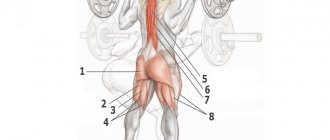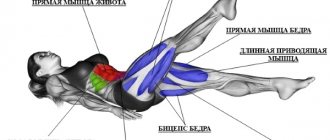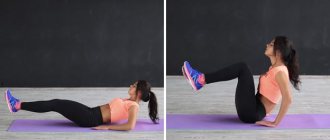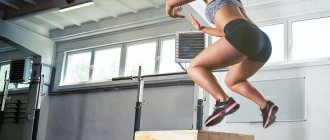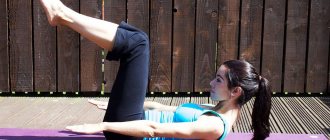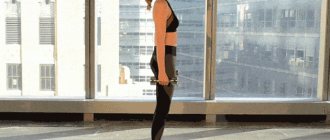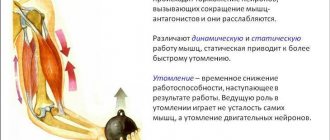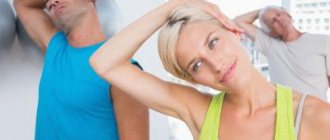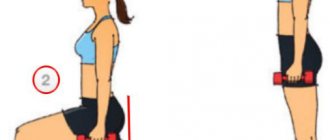Frontal attack
Leg curls are a single-joint exercise that do not require much energy. This is partly due to the fact that here our feet are not on the floor, and therefore there is no need to maintain balance. For this reason, the stabilizer muscles and muscles of the back of the thighs do not work. And, of course, we are not talking about the coordination work of the hip flexor and extensor muscles. However, extensions are indispensable when you need to form a rounded, straight-forward hip. The fact is that extensions specifically act on the central muscle of the quadriceps, the rectus muscle, and the broad intermedius muscle, which lies underneath it and, during hypertrophy, pushes it outward. After extension, the lateral profile of the thigh naturally becomes wider.
You've probably heard that you need to stretch a muscle before exercising. That's why many leg extension machines have an inclined back. To enhance the stretching effect, it is sometimes pushed back as far as possible, and the body assumes an almost supine position. However, scientific research has shown that in the case of extensions, such a technique not only makes no sense, but is even harmful.
From a stretched position, the quadriceps exhibits less strength. Well, the greatest strength is achieved by the direct position of the body. By the way, this position puts maximum load on the rectus muscle. Compare, the load increases by 42%! If, on the contrary, you lean forward, you will be tempted to cheat. It is sometimes useful, but extension is again not the case at all. When the body is tilted, the trajectory of the tibia is distorted, and this increases the load on the anterior cruciate ligament of the knees with the prospect of injury.
MUSCLE & FITNESS №6-7, 2OO6
Basic errors during execution
When it gets to this point, many builders start saying, “This is not about me.” My technique is perfect, etc...." If this is indeed the case, then congratulations. But even in this case, this information may be useful to you. After all, there are a lot of people in the halls who have not yet achieved mastery. And our task is to help them avoid these mistakes!
Heavy weight
This is one of the common mistakes. This is all due to the fact that people overestimate their strength and want to achieve results as quickly as possible. But this approach can only lead to injury and delay progress. Therefore, take a weight that you can safely work with for 10-15 repetitions. And as you feel that you are ready for heavier loads, you can add weight.
Bending jerkily and lifting by inertia
This error follows smoothly from the first. When an athlete cannot cope with the weight, he begins to use the force of inertia. In fact, it looks very terrifying. At the beginning, the legs fall sharply with the load down, and then when they spring back, they are sharply squeezed up. I think it’s clear what consequences this can have. Take care of your knees! Movements must be under your control.
Body displacement during movement
Many athletes have this peculiarity: in order to reduce their fate, they begin to reduce the amplitude of movement. They do this very simply, changing their position on a bench or in a standing exercise machine. That is, they either slide down or, on the contrary, creep up. This changes the position of the roller on the legs. I wrote above that if you shift the weight to your heels, the load goes to your calves. And if you put the roller on your calves, the range of movement will become very short. Therefore, neither option will work the hamstrings.
Good luck to everyone in your training!
Why are they tense?
Most experts, including those sincerely respected by Lechman, are convinced that the hip flexors are tense due to a sedentary lifestyle - a sign of our age. If we sit at a desk for 8 hours a day, our hips will be constantly flexed, and our hip flexors will be tense, contracted, and then difficult to stretch. Despite the attractiveness of this theory, Lekhman refuses to believe in it. He has been dealing with this theory for 15 years and is convinced that its conclusions are not based on anything.
Can prolonged sitting tighten and shorten the hip flexors? No way. And that's why.
- Even if you sit for 8 hours a day without a break, this is not enough for the muscles to become shorter. Shortening occurs when you are in a cast for a really long time, not hours, but days and weeks, and your muscles are shortened and immobile. A sitting person stands up during the day, interrupting this muscle shortening.
- Even if those 8 hours are so terrible, you nullify their effect when you sleep for 8 hours with your legs extended or do something standing. On the other hand, why don't we shorten our thigh muscles if we sleep with our legs bent in the fetal position? Has anyone told their patients that it is harmful to sleep on your side with your knees bent? What about embryos that spend 9 months in a curled up state? Maybe they also have difficulty straightening their legs?
- The way we sit is often contrasted with other cultures that sit differently. In some countries, it is customary to sit in a deep squat, that is, squatting. I wonder how their hip flexors are? Do these people realize the danger of redundancy they are exposed to? Perhaps they should be warned.
Leg extensions while sitting in the machine work the quadriceps
Leg extension in the simulator is an isolating exercise for the quadriceps, which helps to draw relief and improve the shape of this muscle. The technique of performing the movement is quite simple, but it has its own nuances that you need to know for effective and safe leg training.
Muscle work
When performing leg extensions, the main load falls on the quadriceps muscle of the thigh, that is, the quadriceps. It is the largest muscle in the human body and its main function is to extend the knee joint and straighten the leg. This muscle is partially involved in flexion of the hip joint.
The quadriceps is made up of four smaller muscles:
- Rectus femoris muscle - covers the front of the thigh.
- The intermedius muscle of the thigh is also located in front under the straight line.
- Lateralis muscle - forms the outer side of the thigh.
- Medial – respectively, internal.
Seated leg raises, or as they sometimes say, leg extensions in a machine, allow you to work out all the quadriceps bundles, draw out the relief and improve the shape of your legs. Also, performing this exercise helps improve performance in basic movements, such as the squat or leg press.
Extensions are used as a warm-up before the main leg workout, for pre-exhaustion (at an advanced level) or to finish off the quadriceps after basic exercises. As a basic exercise, it can be given to strengthen muscles for beginners for whom basic squats are still too difficult.
Effect of exercise on knees
Separately, it is worth mentioning the effect of extensions on the knee joints. When the legs bend and straighten under the influence of weight, the anterior cruciate ligament experiences significant stress. On the one hand, this creates a risk of injury.
This is why it is important to follow the technique perfectly and use moderate weights.
However, on the other hand, when performed correctly and using light weights, the exercise helps strengthen the knee ligaments. In particular, it is used for the rehabilitation of athletes after injuries. In other words, everything is poison and everything is medicine, both are determined by the dose. In order for the exercise to bring only a positive effect, it must be performed correctly.
Execution technique
At first glance, the exercises couldn’t be simpler than leg extensions in the machine. We sit down on the seat and go. This is partly true, but, as in any business, it has its secrets.
So, first of all, you need to adjust the simulator for yourself. As a rule, two parameters are regulated in the machine - the position of the backrest and the location of the roller behind which you move your legs. Well, and, of course, weight.
- The backrest should be installed so that your thigh fits completely on the seat. That is, so that the knees ideally lie on the edge of the seat, and the sacrum is pressed against the backrest.
- The position of the second roller (by which you place your legs) must be set so that you rest against it with the lower part of your shin. The angle at the knee joint should not be less than 90 degrees.
- The last thing you need to do is set the weight, depending on your level of training. Choose a weight so that you can do 3-4 sets of 15-20 reps. Large weights are not used in this exercise.
Having prepared a “workplace” for ourselves, we proceed to perform the exercise.
- Sit in the machine, press your back against its back and put your feet behind the roller. With your hands, grab the special handles on the sides of the seat. Lift your toes up.
- As you exhale, smoothly straighten your knees. Tighten your quadriceps as much as possible at the top point and hold in this position for 1–2 seconds.
- As you inhale, lower your legs down under control, but do not bend them all the way. That is, even at the lowest point, the quadriceps should be tense. Watch the sensations in your knees, do not suddenly throw your legs down.
- Perform the required number of repetitions.
Among the variations of this exercise, you can indicate performing extensions alternately, first with one leg, then with the other. This approach helps some people better feel the work of the muscles, or it can be used if there is asymmetry.
You can also straighten your legs by turning your toes in or out. When turning outward, the load shifts towards the inner (medial) head of the quadriceps; when turning inward, the load shifts towards the outer (lateral) head.
This is interesting: Scissor squats: technique for performing squats in a Smith machine with legs in line, notes and practical recommendations for shifting the load to the gluteal muscles
Useful tips
- The gluteal muscle needs a strong contraction for its fibers to begin active growth. To do this, you need to raise your knee as high as possible in the starting position, and then hold it there during extensions.
- At the lowest point of the amplitude, it is important not only to keep the knee suspended, but also to bring it slightly closer to the chest. This will further shrink the buttocks.
- To increase the effectiveness of the exercise, weights or just heavy boots are put on the lower leg. With their help, the buttocks will be worked out even better.
- It is recommended to perform a minimum of 20 repetitions over 3-4 sets.
- You can linger at the top point of the amplitude, but only for one second, since holding the knee for a long time will relax the muscle.
A properly made protein shake can build muscle in no time!
Learn how to perform barbell wrist curls here.
And if you are interested in wide-grip push-ups from a bench, then this is for you - /silovye/s-grud/otzhimaniya-shirokim-hvatom-ot-lavki.html.
Working muscles
The main muscles under load when performing seated leg curls will be:
- Biceps femoris (biceps femoris). Receives key load when working.
- The semitendinosus and sartorius muscles receive auxiliary load. These muscles are located on the medial (inner) part of the thigh. They, like the biceps muscle, help bend the leg at the knee.
- The calf muscles are also involved in the work, but only slightly.
To perform the exercise you will need the following equipment:
Seated leg curl machine;
Exercise technique:
- Adjust the machine's lever to suit your height and sit in the machine with your back pressed against the back support.
- Place your shins on the top of the machine's lever roller (your feet are placed on the machine's roller just below your shins) and place a pad on your knees that rests on your thighs, just above your knees. Next, grab the side handles of the machine with your toes straight (or you can also use either of the other two positions described at the beginning of the chapter) and make sure that you can straighten your legs completely forward. Lean your back slightly. This is your starting position.
- As you exhale, bend your knees, pressing on the roller of the machine and try to move the lever as close as possible to the back of your thighs. Keep your body still throughout the entire exercise. Keep your legs bent for a second.
- As you inhale, slowly return to the starting position.
- Repeat these steps for the recommended number of repetitions.
Since the exercise is isolated, when training legs it is recommended to do it after performing basic exercises, such as straight leg deadlifts. The number of repetitions in an exercise is usually in the range of 12-16. Number of approaches: 4.
Tips for implementation:
To get the most benefit from the exercise, pay attention to the following tips: Perform the lowering phase of the machine rollers, after bending the legs at the knee joints, more slowly than raising them; Do not straighten your legs completely at the knees, keep them slightly bent; Try to bend your legs to the maximum possible amplitude; At the peak point of the amplitude, feeling the contraction in the muscles of the back of the thighs, fix the position and pause for 1 second; Before performing, it is necessary to correctly adjust the machine so that its rollers are not too high, and also that your legs are not completely straight. Otherwise, this will increase the risk of injury to the knee joints; During the entire approach, the hip joint remains motionless on the seat of the machine; If you have problems with your knee joints, do not use too heavy a weight on the machine. It is better to perform the approach with less weight, but in full amplitude and with the correct technique; Exhale when bending your legs, and inhale when lowering them (extension); Never use excessive weight when performing seated leg curls when you begin to use jerking and swinging exercises because this can create a risk of both lower back and hamstring injuries.
It is better to perform the approach with less weight, but in full amplitude and with the correct technique; Exhale when bending your legs, and inhale when lowering them (extension); Never use excessive weight on the seated leg curl exercise when you begin using jerks and swings because this can put you at risk for both lower back and hamstring injuries.
Options:
- It is also possible to perform bends with each leg in turn using a special simulator. Use a variety of exercise machines available to you, which will allow you to effectively train all areas of your leg muscles.
- Since you can use three leg positions, there are actually three different exercises available to you.
Programs
The hip extension exercise, regardless of its purpose, is included in most programs for women. Many men often exclude him from their programs, but in vain!
| Program | Number of repetitions | For what |
| Split (leg day) | 3*12 in the simulator. After the basic ones. | Maximizing the load on the back surface of the problem (here is a selection of exercises) |
| Circular (second cycle) | 5*20. Performed solo (in crossover) | To pre-exhaust the hamstrings before classic rows. |
| Home | 5*max – free weights | Keeping the target group in good shape |
| Crossfit | 5*20. Performed solo (in crossover) | Improves functional strength, helps with burpee exercises |
Indications for exercises
The quadriceps leg muscle consists of 4 small muscles:
| straight | covers the front of the thigh |
| intermediate | located in front under the straight line |
| lateral | the outer part of the thigh is formed from it |
| medial | located in the inner thigh |
Extending the legs in the simulator helps to work out 4 types of muscles and improves the shape of the legs.
Raising your legs on a machine in a sitting position helps to work out all 4 types of muscles at once, helps to better define the relief and improve the shape of your legs. Performing this exercise also improves other performance in basic movements, such as squats or leg push-ups.
Leg extensions in the simulator are recommended as a warm-up before starting intensive training of the leg muscles, in order to pre-tire the limbs or to finish off the quadriceps after performing basic exercises. This exercise may be suitable for beginners who want to strengthen their muscles if basic squats are still difficult for them.
Also, it is these extensions that have a positive effect on the knee joints. When the legs bend and extend under weight, the load goes directly to the cruciate ligament. This may be dangerous and there is a risk of injury
Therefore, it is important to strictly adhere to technique and moderate weight during exercise.
You can often see girls using this simulator. Representatives of the fair sex with a thin build will benefit from such exercises. During squats, such exercises can prepare the knee joint, protect it from injury, and improve the performance of basic exercises.
But for girls who play sports professionally and have plump bodies, such a complex will be superfluous. The thing is that the muscles in the legs actively work and in basic exercises they do not require additional load. If you still include them in your workout, you can greatly increase the volume of your hips.
This set of exercises is perfect for men who want to improve their performance, build muscle mass, and make their muscles more prominent and symmetrical. Exercises on a leg extension machine are an excellent rehabilitation method after a leg injury.
Roman chair crunches
Classic: this simulator is everywhere, despite the fact that it is not very anatomically convenient, because forces a person to lift with a straight back. The fact is that the main task of our press is to twist the pelvis to the body or the body to the pelvis. When you secure your feet in cushions below your pelvis, you make this kind of twisting more difficult. The load on the lower back, hips and iliopsoas muscles increases, and the load on the abs decreases. If you add weight to this (and many manage to do this exercise with weights from a barbell), then you can easily injure your lower back.
What to do? Read the article “Analysis of the most effective abdominal exercises” and create a competent abdominal training program.
Execution technique
Initial position
- The hyperextension machine is adjusted so that the length from the pad to the foot allows you to avoid hyperextension of the knees;
- The emphasis is placed on the simulator with the feet and hips on the pillows;
- Inhale and exhale; as you exhale, the stomach is drawn in and the back is rounded;
- Starting position – the body “hangs” down, the back is rounded in the thoracic region, the stomach is retracted;
Movement
- From the bottom position, extension is performed at the hip joint;
- With the force of the muscles of the buttocks, the body rises in line with the biceps of the thighs;
- The rounding of the spine in the thoracic region is preserved;
- The buttocks at the top point are additionally tensed statically;
- Lowering occurs relatively slowly, without inertia
HYPEREXTENSION ON THE GLUTES.
Exercise options
Due to increasing progress and various experiences in the field of anatomy and the effects of exercise on muscles, it has been proven. That the hip can work in several planes. Standing, sitting and lying down. Therefore, various exercise machines have been developed and we can choose the one in which our muscles work maximum.
Leg bending in a lying machine
It’s not for nothing that I mentioned this option first. This is because he is very famous in many halls. I think you won’t ignore it either. There are several types of simulator, but in principle they all perform the same function. They can be divided according to the type of bench: horizontal and curved. And also by type of loading: cable with weights and regular with pancakes. In principle, there is no big difference between them. But it is still better to give preference to a curved bench. Its shape helps achieve maximum insulation. At the same time, your pelvis is raised slightly upward. This allows for a stronger stretch of the thigh muscles at the bottom. Consequently, they will receive a much greater load, and this will only increase their growth rate.
Initial position:
- Go to the simulator. Set it to the weight you need (set the weights or set the limiter to the weight you need).
- Lie on a leg curl bench with your knees extending beyond the edge of the bench. If you have a horizontal bench, then lift your pelvis up a little.
- Place your feet under the special roller of the machine. It should be located above the heels. Grasp the handles with your hands.
Leg bending while sitting in a machine
The sitting option is also very famous. It is especially common during training in the “Superset” style. This is when you do several exercises in a row in one approach without rest. Basically, they choose to do leg extensions while sitting on the quadriceps, and then immediately do curls in the same machine. This is very convenient because you don’t have to run around the hall. But if we are talking about ordinary linear training, then bending the legs while sitting is inferior to the lying option. All because of the inconvenience of the simulator itself. Firstly, to prevent you from being thrown up by the weight of the weight, a special roller presses on your legs from above. Sometimes, of course, it fits perfectly in terms of the amount of lift. But in most cases, it either squeezes the legs or, on the contrary, goes too high. Secondly, it is very difficult to focus on the work of the biceps muscles. This is because during bending you will need to move your pelvis forward a little to feel the hamstrings and increase the range of motion. And as you know, if you do two things at once, which one will lag behind. Conclusion: if you train using the superset system, or you don’t have another machine in the gym. Then the sitting option will be a good helper for you.
Initial position:
- Once you have set the weight you need, sit on the machine. Rest your back against the backrest.
- Place your feet on the bolster. So that it is under the calf muscles closer to the heel. Your knees should extend beyond the edge of the seat. Place a bolster on top to hold your legs. It should be located just above the knee joints.
- Lean back and grab the special handles with your hands.
Standing leg curl in the simulator
This is the technically simplest version of leg curls. But unfortunately its popularity is quietly fading. Nowadays, not many medium-sized gyms can boast of having such a machine where you can do leg curls while standing. And this news is very disappointing, because there are a lot of advantages in this option.
- Maximum hamstring isolation.
- Large range of motion, and this, as we remember, has a beneficial effect on muscle growth.
- The back is completely excluded from the exercise, so it will be easy for both beginners and professionals. And also for people with back injuries, of course not significant.
- Working on each thigh separately. Of course, this can be done in the other two options, but they will not be as convenient.
You can see how many positive points can be highlighted in this exercise. But of course there are several disadvantages. If you work your legs separately, it will take twice as long. And due to the fact that now time is a very important resource, many simply do not have enough of it. Therefore, more and more people are abandoning one-sided training.
Initial position:
- Set the desired weight. Place one of your legs (right or left) under the cushion. Just like everywhere else, it should be below the calf muscles. Place the knee of the same leg against the lower movable platform. Place your other foot on the floor.
- Grasp the handles with your hands. Some simulators provide special supports for the elbows and torso.
When, to whom, why?
Perhaps it’s worth starting with the fact that hip extension is an isolated single-joint exercise. And that means it:
- not suitable for developing muscle mass;
- does not help improve strength performance;
- performed after basic exercises (Romanian deadlift);
- not performed by male athletes in the first year of training;
- has a relatively simple range of motion and technique;
- develops muscle relief.
It is precisely because of these qualities that women especially love him, because using hip extensions, whether in simulators or in a crossover, they dry out and tighten exclusively the target muscle group of the leg, which allows them to get an ideal figure. Does it have any contraindications? If you do not have problems with joints or acute necrosis of bone tissue, then you can safely perform hip extensions. This exercise does not place stress on the spine, abdominal muscles or other target groups that require insurance.
When and who should do hip extensions in the machine. When – after fully mastering the circular basic program (15-30 workouts). During this time, the body adapts to the load, all muscle groups become toned, and the necessary amount of glycogen is stored for exercise. For anyone who wants to tighten the back of their legs. For women, the priority is to work with light weights in exercise machines. For men - hard work, after basic lifts!

